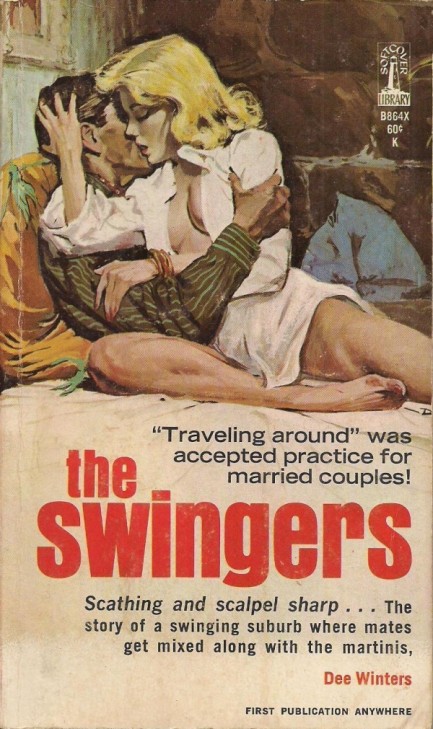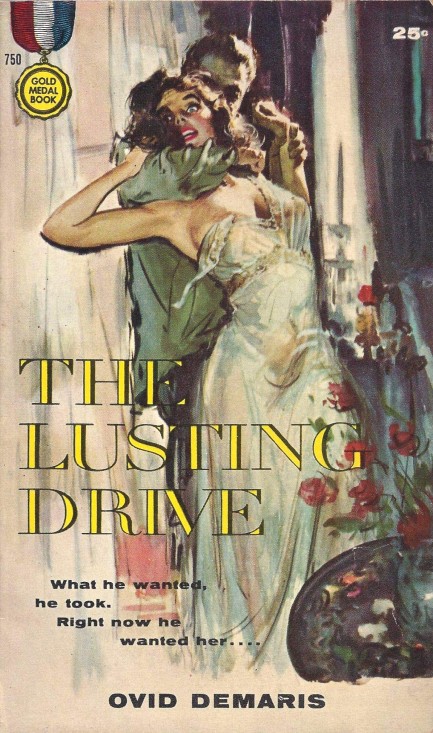 I want to remember everything about this experience. For starters tell me your name. 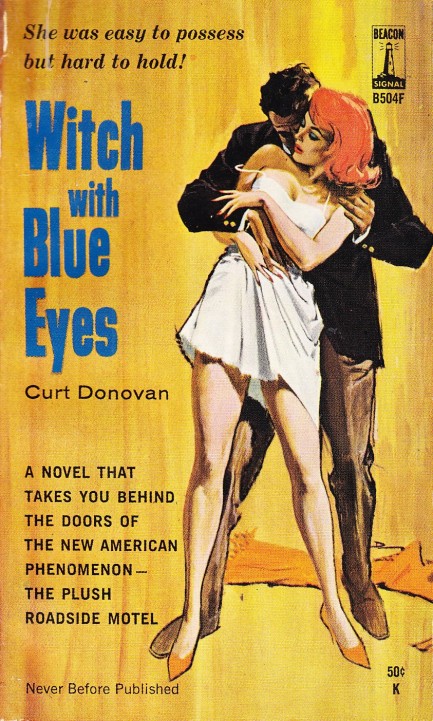
The 1962 novel Witch with Blue Eyes, which you see here with its Ernest Chiriacka cover art, is about a man who quits a big hotel operation, hires on as manager of the Snug Haven roadside motel, but must battle two craven partners in order to turn it from a shady dive into a respectable success. The hours and stress test his marriage to the owner's daughter, and problems worsen when his former lover—the eponymous witch with blue eyes—arrives on the scene (accompanied by her evil cat Big Bad) to ruin him. The book was presented by publishers Beacon-Signal as sleaze, but it's virtually sexless, and as a pure drama it's flatter than a flapjack. We suggest you don't check in to this motel.
 No man who dumps her ever lives to regret it. 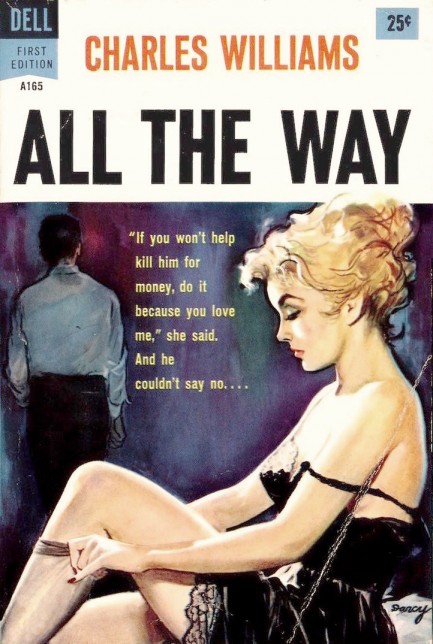
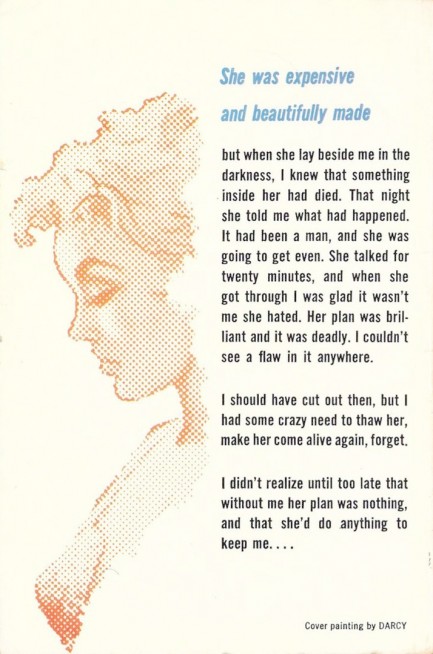 One day there will be no more Charles Williams for us to read, and that'll be sad, but his books, like good wine, are something you have to treat yourself to regularly even as the stock dwindles. His 1958 novel All the Way, which is the source material for the 1960 movie The 3rd Voice, is typically solid Williams work. One day there will be no more Charles Williams for us to read, and that'll be sad, but his books, like good wine, are something you have to treat yourself to regularly even as the stock dwindles. His 1958 novel All the Way, which is the source material for the 1960 movie The 3rd Voice, is typically solid Williams work.
It has a fascinating plot at its center. A vengeful woman enlists a fugitive to help her steal her former lover's identity, then impersonate him for weeks afterward so nobody will suspect when he disappears that she's actually killed him. The reason people are supposed to assume a disappearance instead of murder has to do with paranoid schizophrenia in the ex-lover's family, and the fact that the fugitive impersonating him has been faking its rapid onset, publicly and loudly.
With the ground laid in this way, a disappearance will be the logical conclusion, and since the man is rich, the fact that a hundred seventy grand is missing from his bank accounts merely indicates he's never coming back—not that an imposter has withdrawn the cash. The scheme is convoluted, but the genius femmes who come up with them are a staple of pulp literature. Williams gets the job done again, as does Ernest Chiriacka, who painted the cover art.
 For every job there's a perfect tool. 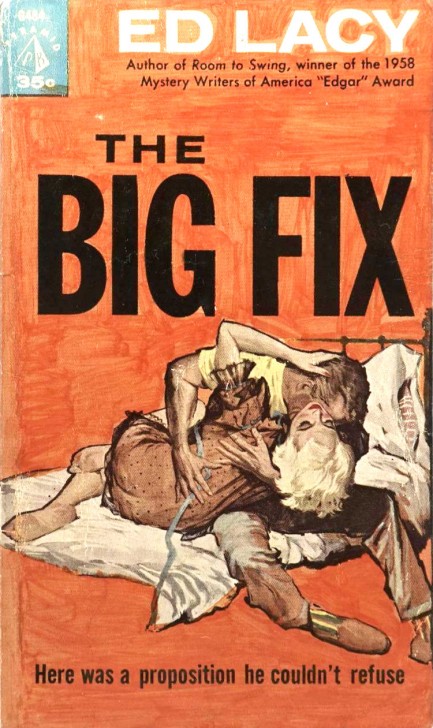
In Ed Lacy's 1961 boxing drama The Big Fix, the fix is defnitely in, and in the worst way possible. Tommy Cork, a thirty-something middleweight boxer who in his prime battled Sugar Ray Robinson, becomes the pet project of a dilletante boxing manager who promises that with the best training, diet, and promotion Cork can reach the top again. Sounds good, but Tommy has unwittingly become the focus of a deadly scam, a plan to find some desperate boxer with a reputation for ugly losses, make a show of training him for high profile bouts, all the while taking out a life insurance policy on him, then having a hammerfisted accomplice kill him in the ring. Since the murder will happen before a crowd, there will be no suspicion of foul play, particularly for a pug known for fighting stubbornly and hitting the canvas hard.
But nothing is straightforward in Lacy's hands. Tommy's wife May, hopeful for a better life, gets into trouble with violent numbers runners, an aspiring writer sees the couple as the perfect pathetic characters to be the focus of a novel, an ex-boxer cop starts to get wise to the murder scheme, and other twists come from nowhere to infinitely complicate the tale. Despite the subplots, as readers you know the only fitting climax is one that takes place in the ring, and Lacy pushes the story inexorably toward that showdown, hapless Tommy facing off against a man who plans to kill him with a relentless assault, or if possible a single blow. If he's going to have help, he'll need to provide it himself. As usual, Lacy tells a good story. He's reliably full of excellent ideas. That also goes for Ernest Chiriacka, who painted the eye-catching cover.
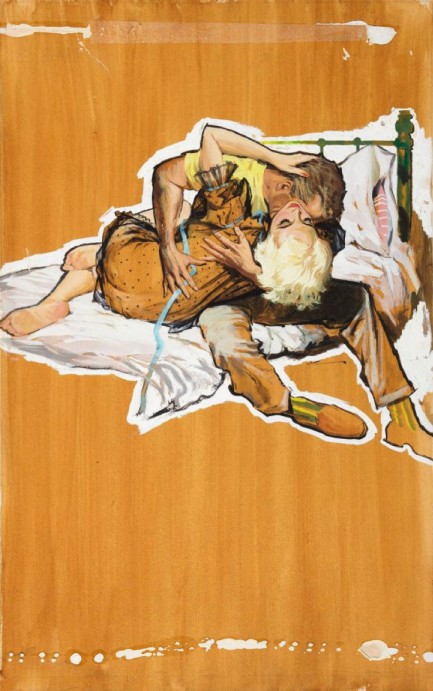
 Is sex déjà-vu a thing? Because I feel like we've lived this before. Try not to finish so fast this time. 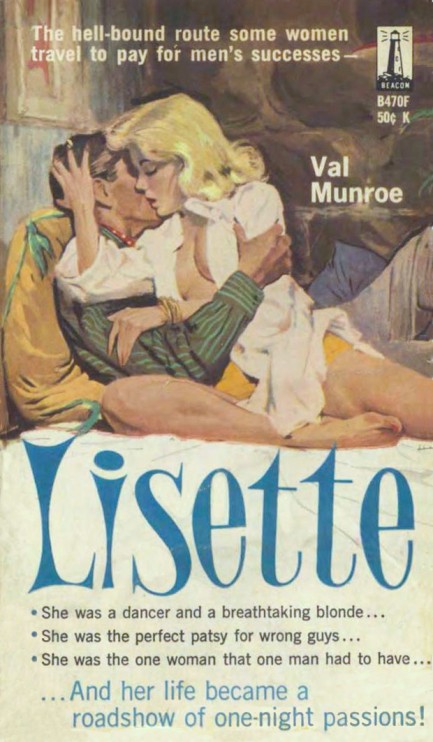
Above: a cover for Val Munroe's Lisette, painted by Darcy, aka Ernest Chiriacka for Beacon Signal, 1962. We were surprised when we discovered this was Munroe's Carnival of Passion under a different title. Since the name of the main character is Lisette rather than Liz, we didn't guess it was the same book, and you'll also notice the cover doesn't mention a carnival. Luckily we didn't pay for this because it was available for download on Archive.org. By the way, the story wasn't the only thing repeated here. The art was later paired with Dee Winters' 1965 sleazer The Swingers, as you see below.
 Okay... love you too... too tight... need to breathe now... 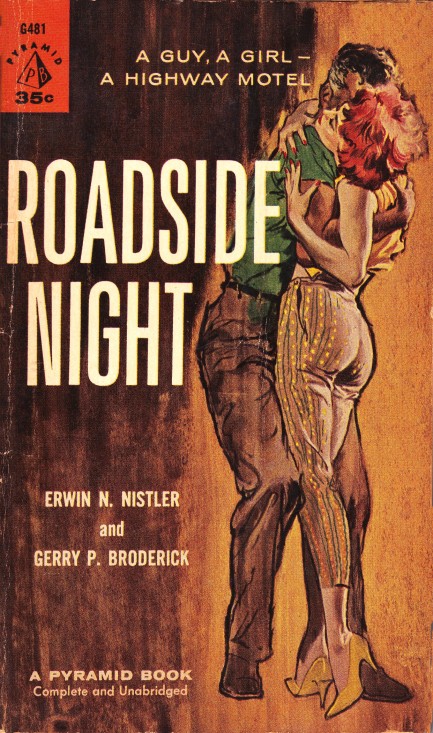
This is a classic cover from highly respected paperback artist Ernest Chiriacka, aka Darcy, one of his very best. He specialized in couples. Embracing couples, smooching couples, angry couples, pensive couples, but in most cases his work has the same sort of feel you see above. We've put together a collection to show you in a bit. In the meantime, let this excellent example whet your appetite, and remember—if you love somebody set them free.
 Everybody's gotta go sometime. 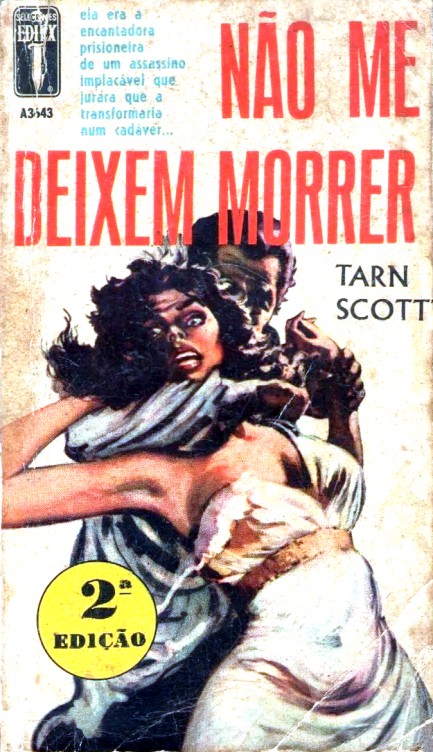
We don't find much Brazilian pulp, but above is an interesting—if battered—cover for Tarn Scott's, aka Walter Szot and Peter G. Tarnor's Não Me Deixem Morrer, which is a translation of their U.S. released 1957 kidnapping tale Don't Let Her Die, a book we read and enjoyed a few years ago. This was put out by the Rio de Janeiro based imprint Ediex for its Selecrimes series in 1964. We gather that Ediex was a branch of the Mexico City publisher Editormex Mexicana, and that the company released quite a few translations of English crime books during the 1960s.
The art, which is by an unknown, is a low rent copy of that found on the cover of 1958's The Lusting Drive by Ovid Demaris, which you see below. That cover is also uncredited, but some think it's by Ernest Chiriacka. We agree. In fact, we don't think there's any doubt. Not only is the style—particularly of the female face—a dead match, but Chiriacka was pumping out illos by the cartload for Gold Medal during the mid- to late-1950s. So we're going to go ahead and call this one a lock. We may share a few more Brazilian paperback covers in a bit. Stay tuned.
 This is a Dior blouse you've managed to ruin, FYI, just in case you have anything resembling a human soul. 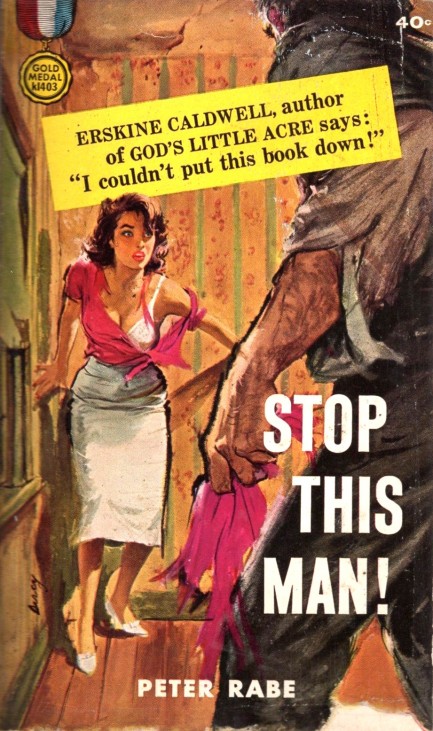
The lead character in Peter Rabe's Stop This Man is a jackass, but he isn't a rapist. This cover by Darcy, aka Ernest Chiriacka, does capture his essential nature, though, as he's bossy as hell and sees woman mainly as objects to be possessed or manipulated. When he intrudes into the back room of a club and encounters a female employee changing clothes he intimidates her into continuing so he can see her naked. As often happens in mid-century crime novels, she decides this makes him a real man and falls for him. It's not rape but it's definitely rapey. But of course us modern readers are aware of this going in, right? The sexism, the racism, all the rest, are features of 1950s crime literature. Each person needs to decide whether there's something to be gained in the fiction despite its affronts to societal values.
In Stop This Man lots of people are trying to stop Tony Catell, but not from harassing women. They want to thwart his criminal master plan. In mid-century crime fiction the main character is often in possession of an ill gotten item he expects to open the gateway to a better life. It may be money or bearer bonds or a rare diamond. Here the item is a thirty-six pound ingot of stolen gold. Catell hopes to fence it but the trick is to find an interested party who will give him a good price. Did we forget to mention that it's radioactive? There's always a catch, right? People who come into extended contact with this brick of gold die, but that doesn't stop Catell. He wraps it in an x-ray technician's lead lined apron and travels from Detroit to L.A. seeking a buyer for this lethal hunk of heavy metal.
Catell is kind of radioactive too, actually, in the sense that he's bad news through and through. He plans to sell his killer treasure, but has no idea the radiation is turning it into mercury. It's a cool set-up for a thriller by Rabe in his debut novel. You may be thinking 1952's Kiss Me, Deadly did it first, but Spillane's novel does not have the radioactive suitcase made famous by the movie adaptation, so this could be—could be, because we haven't read every book out there—the first time this nuclear gimmick appeared. It was originally published in 1955, which means it's also possible the nuclear angle was influenced by Kiss Me Deadly the film, which appeared in May the same year. But while Stop This Man is cleverly set up and is as hard-boiled as any crime novel we've come across, overall we felt it should have been executed at a higher level.
 In the naked city there are a million reasons to kill and die. 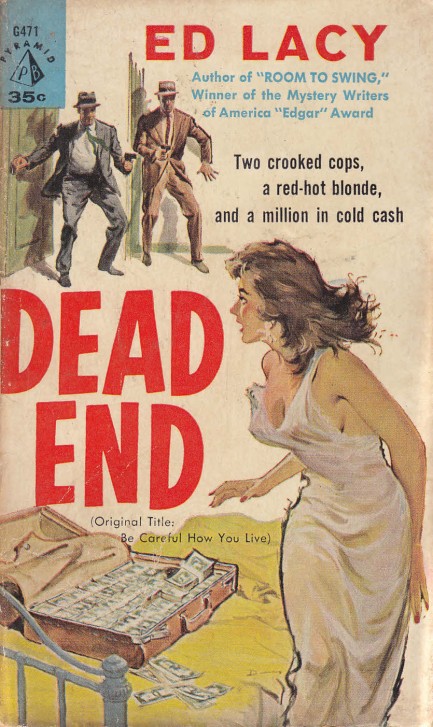
In Dead End two crooked cops end up with a million dollars in dirty money and decide to ditch their jobs and flee the country. But their law enforcement colleagues are after them, so first they hole up in an old Prohibition hideout to let the heat dissipate. How long will they stay in this little room? As long as it takes. The older cop Doc suggests months. The younger cop Bucky is going crazy in days. You know for a certaintly that this partnership isn't going to end well. Lacy is up and down as a writer but this is him on the upswing. Originally published as Be Careful How You Live in 1959, this Pyramid paperback appeared in 1960 with cover art by Ernest Chiriacka.
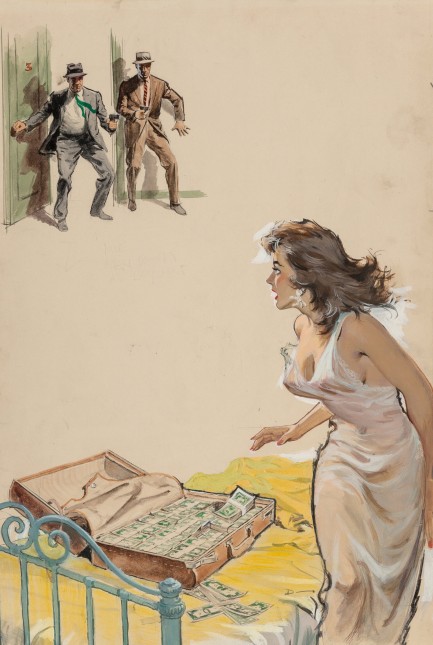
 Psst. Guess what unspeakable perversion I'm thinking about right now. 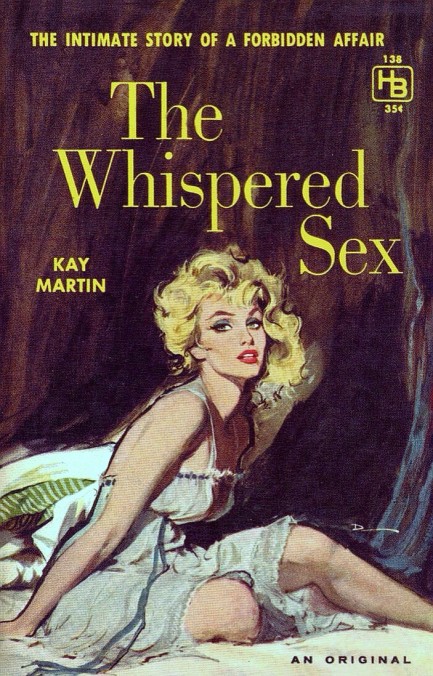
The Whispered Sex isn't about perversion at all, unless you assess it in 1960 terms. It's lesbian fiction involving a Los Angeles woman who is unshakably heterosexual—until she meets the right woman, a slinky nightclub singer with a bigger-than-life persona and a blazing sex drive. But even though the protagonist feels an immediate and powerful attraction, it takes some doing to nudge her into the singer's arms—namely sexual abuse by the man she had come to L.A. in hopes of marrying. After he proves himself to be a slimeball, the heroine escapes by moving into the singer's house—which is filled with more lesbians. From there things get complicated. Author Kay Martin was a pseudonym used by Adela Maritano, who was also responsible for A Taste of Passion. The excellent cover art here was painted by Ernest Chiriacka, who signed it as his alter ego Darcy. You can see a bit more from him here.

|
 |

The headlines that mattered yesteryear.
2003—Hope Dies
Film legend Bob Hope dies of pneumonia two months after celebrating his 100th birthday. 1945—Churchill Given the Sack
In spite of admiring Winston Churchill as a great wartime leader, Britons elect
Clement Attlee the nation's new prime minister in a sweeping victory for the Labour Party over the Conservatives. 1952—Evita Peron Dies
Eva Duarte de Peron, aka Evita, wife of the president of the Argentine Republic, dies from cancer at age 33. Evita had brought the working classes into a position of political power never witnessed before, but was hated by the nation's powerful military class. She is lain to rest in Milan, Italy in a secret grave under a nun's name, but is eventually returned to Argentina for reburial beside her husband in 1974. 1943—Mussolini Calls It Quits
Italian dictator Benito Mussolini steps down as head of the armed forces and the government. It soon becomes clear that Il Duce did not relinquish power voluntarily, but was forced to resign after former Fascist colleagues turned against him. He is later installed by Germany as leader of the Italian Social Republic in the north of the country, but is killed by partisans in 1945.
|

|
|

It's easy. We have an uploader that makes it a snap. Use it to submit your art, text, header, and subhead. Your post can be funny, serious, or anything in between, as long as it's vintage pulp. You'll get a byline and experience the fleeting pride of free authorship. We'll edit your post for typos, but the rest is up to you. Click here to give us your best shot.

|
|









 One day there will be no more Charles Williams for us to read, and that'll be sad, but his books, like good wine, are something you have to treat yourself to regularly even as the stock dwindles. His 1958 novel All the Way, which is the source material for the 1960 movie The 3rd Voice, is typically solid Williams work.
One day there will be no more Charles Williams for us to read, and that'll be sad, but his books, like good wine, are something you have to treat yourself to regularly even as the stock dwindles. His 1958 novel All the Way, which is the source material for the 1960 movie The 3rd Voice, is typically solid Williams work.




